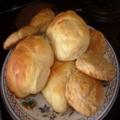In most of Wales, Northern England, parts of Scotland, and some areas of Southern England, the three main meals are referred to as "breakfast, dinner and tea" or "breakfast, lunch and tea" where in other areas they might be "breakfast, lunch and dinner". Afternoon tea is a light meal typically eaten between 3pm and 5pm. It originated in the United Kingdom, though various places that used to be part of the former British Empire also have such a meal. However, changes in social customs and working hours mean that most Britons only take afternoon tea on special or formal occasions.
Traditionally, loose tea would be served in a teapot with milk and sugar. This would be accompanied by various sandwiches (customarily cucumber, egg and cress, fish paste, ham, and smoked salmon), scones (with butter, clotted cream and jam) and usually cakes and pastries (such as Battenberg, fruit cake or Victoria sponge).
While afternoon tea used to be an everyday event, nowadays it is more likely to be taken as a treat in a hotel, café, or tea shop, although many Britons still have a cup of tea and slice of cake or chocolate at teatime. Accordingly, many hotels now market a champagne cream tea.
High tea is an early evening meal, typically eaten between 5pm and 6pm in the evening. It would be eaten as a substitute for both afternoon tea and the evening meal. The term comes from the meal being eaten at the "high" (main) table, instead of the smaller lounge table. It would usually consist of cold meats, eggs and/or fish, cakes and sandwiches. In a family, it tends to be less formal and is an informal snack (featuring sandwiches, biscuits, pastry, fruit and the like) or else it is the main evening meal.
On farms or other working class environments, "high tea" would be the traditional, substantial meal eaten by the workers immediately after nightfall, and would combine afternoon tea with the main evening meal.

